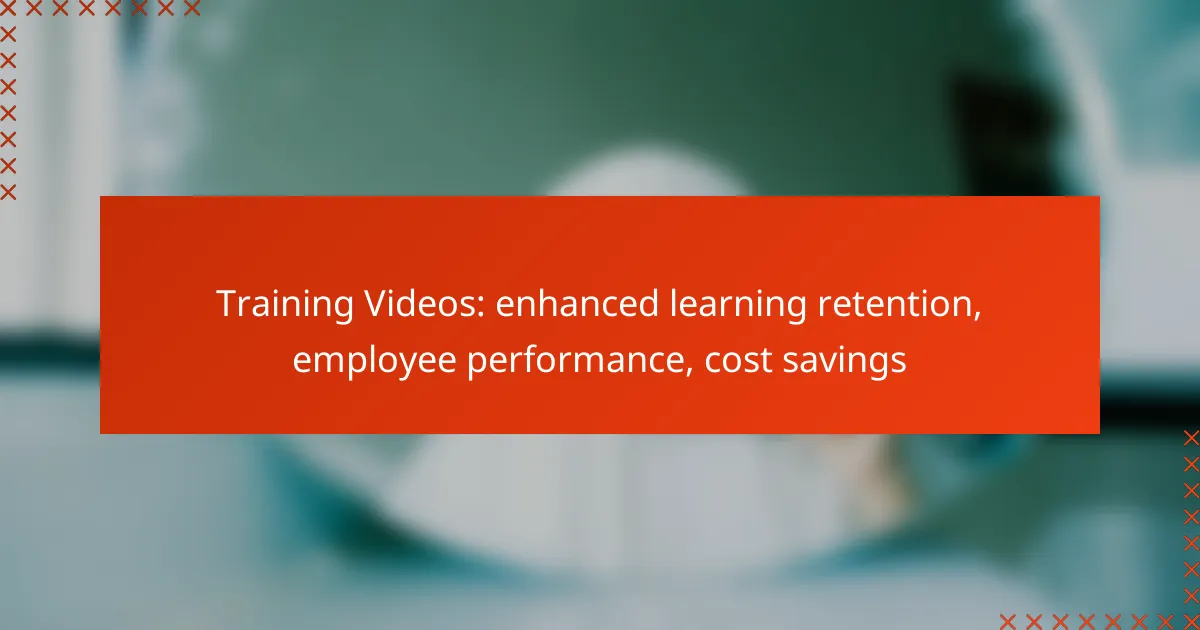Training videos are a powerful tool for enhancing learning retention and improving employee performance. By integrating visual and auditory elements, these videos cater to diverse learning styles, making it easier for employees to grasp and retain key information. Additionally, they offer a cost-effective solution by streamlining the training process and reducing overall expenses.

How do training videos enhance learning retention?
Training videos enhance learning retention by combining visual and auditory elements, making it easier for employees to remember key information. This multimedia approach caters to various learning styles and helps reinforce concepts through engaging content.
Visual engagement increases memory recall
Visual engagement plays a crucial role in memory recall by capturing attention and making information more relatable. When learners see images, animations, or demonstrations, they are more likely to remember the material compared to text-based formats alone.
For example, using infographics or video scenarios can illustrate complex ideas effectively. This method can lead to retention rates that are significantly higher than traditional training methods.
Repetition reinforces key concepts
Repetition is a powerful tool in training videos, as it allows learners to revisit important concepts multiple times. This reinforcement helps solidify knowledge and makes it easier to retrieve information later.
In practice, incorporating summary segments or quizzes at the end of each video can enhance this effect. By revisiting key points, employees can better internalize the material, leading to improved performance on the job.
Interactive elements boost participation
Interactive elements in training videos, such as quizzes, polls, or clickable scenarios, significantly boost participation and engagement. These features encourage learners to actively think about the content rather than passively watching.
For instance, a video that includes decision-making scenarios allows employees to apply what they’ve learned in real-time. This hands-on approach not only enhances retention but also fosters a deeper understanding of the material.

What impact do training videos have on employee performance?
Training videos significantly enhance employee performance by improving skill retention and facilitating knowledge transfer. They provide a visual and auditory learning experience that caters to various learning styles, ultimately leading to better job performance and productivity.
Improved skill acquisition
Training videos enhance skill acquisition by breaking down complex tasks into manageable segments. This allows employees to learn at their own pace, revisiting challenging sections as needed. For instance, a video demonstrating a new software tool can show step-by-step processes, making it easier for employees to grasp the necessary skills.
Additionally, incorporating quizzes or interactive elements within the videos can reinforce learning and ensure that employees are absorbing the material effectively. This method can lead to a more competent workforce that is better equipped to handle job responsibilities.
Faster onboarding processes
Training videos streamline onboarding by providing new hires with essential information quickly and efficiently. Instead of lengthy manuals or in-person training sessions, videos can deliver key content in a concise format, reducing the time it takes for new employees to become productive. For example, a company might use a series of short videos covering company policies, culture, and job-specific tasks.
Moreover, this approach allows for consistent training across all new hires, ensuring everyone receives the same foundational knowledge. As a result, organizations can expect new employees to reach full productivity faster, often within weeks rather than months.
Higher employee satisfaction rates
Training videos contribute to higher employee satisfaction rates by providing engaging and flexible learning options. Employees appreciate the ability to learn at their convenience, which can lead to a more positive attitude toward training initiatives. When employees feel supported in their development, they are more likely to be satisfied with their jobs.
Furthermore, effective training can reduce frustration and confusion, leading to a more harmonious workplace. Companies that invest in quality training resources often see lower turnover rates, as employees feel valued and empowered to grow within the organization.

How can training videos lead to cost savings?
Training videos can significantly reduce costs by streamlining the learning process and minimizing resource expenditure. By utilizing video content, companies can enhance employee performance while lowering overall training expenses.
Reduced training time and expenses
Training videos can condense complex information into digestible segments, allowing employees to learn at their own pace. This flexibility often results in shorter training durations compared to traditional methods, which can save both time and money. For instance, organizations may find that video training can cut training time by 30-50%.
Additionally, training videos can be reused across multiple cohorts, further decreasing the need for repeated live training sessions. This not only saves on instructor fees but also reduces the costs associated with preparing training materials.
Minimized travel costs for training
By implementing training videos, companies can eliminate the need for employees to travel for in-person training sessions. This can lead to significant savings on travel expenses such as airfare, accommodation, and meals. For example, a company that previously spent thousands on travel for training can redirect those funds towards other critical areas.
Remote training through videos allows employees to engage in learning from any location, which is particularly beneficial for organizations with a distributed workforce. This flexibility can enhance employee satisfaction and retention as well.
Lower turnover rates through effective training
Effective training through videos can lead to increased employee satisfaction and retention, ultimately reducing turnover rates. When employees feel well-equipped and confident in their roles, they are less likely to seek employment elsewhere. Companies that invest in comprehensive training programs often see turnover rates decrease by 20-30%.
Moreover, training videos can provide consistent messaging and information, ensuring that all employees receive the same quality of training. This uniformity helps foster a strong company culture and enhances overall employee engagement.

What are the best practices for creating effective training videos?
Effective training videos enhance learning retention and boost employee performance by following specific best practices. These practices ensure that the content is not only informative but also engaging and easy to understand.
Clear objectives and outcomes
Establishing clear objectives and outcomes is crucial for effective training videos. Define what learners should know or be able to do by the end of the video, which helps in structuring the content accordingly.
For instance, if the goal is to teach a new software tool, outline specific features that users should master. This clarity helps in maintaining focus and measuring success post-training.
High-quality production values
High-quality production values significantly impact viewer engagement and comprehension. Use clear audio, sharp visuals, and appropriate lighting to create a professional appearance that keeps learners interested.
Investing in good equipment or professional editing can make a difference. For example, videos with clear sound and visuals can improve retention rates by up to 50% compared to poorly produced content.
Engaging storytelling techniques
Incorporating engaging storytelling techniques can make training videos more relatable and memorable. Use real-life scenarios or case studies to illustrate key points, making the content applicable to learners’ everyday experiences.
Consider using a narrative arc—introducing a challenge, exploring solutions, and concluding with a resolution. This approach not only captures attention but also aids in better retention of the material presented.

What tools are available for creating training videos?
Several tools are available for creating training videos, each offering unique features that enhance the production process. Popular options include Camtasia for screen recording, Adobe Premiere Pro for editing, and Vimeo for hosting and sharing the final product.
Camtasia for screen recording
Camtasia is a powerful tool designed specifically for screen recording and creating instructional videos. It allows users to capture their screen activity, making it ideal for software tutorials or presentations.
When using Camtasia, consider its user-friendly interface, which simplifies the recording process. Additionally, you can add annotations, effects, and transitions to enhance viewer engagement. A common pitfall is neglecting to plan your recording; having a clear script or outline can significantly improve the final product.
Adobe Premiere Pro for editing
Adobe Premiere Pro is a professional-grade video editing software that provides extensive tools for refining your training videos. It supports various formats and offers advanced features such as multi-track editing, color correction, and audio enhancement.
While Premiere Pro is powerful, it has a steeper learning curve compared to simpler editing tools. It is essential to familiarize yourself with its interface and functionalities to maximize efficiency. A good practice is to keep your edits concise and focused, ensuring that the training content remains engaging and informative.
Vimeo for hosting and sharing
Vimeo is an excellent platform for hosting and sharing training videos, offering high-quality playback and customizable privacy settings. It allows you to control who can view your content, making it suitable for internal training programs.
When using Vimeo, take advantage of its analytics features to track viewer engagement and performance. This data can help you refine future training sessions. Remember to optimize your video titles and descriptions for better discoverability, as this can enhance the reach of your training materials.



